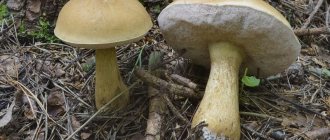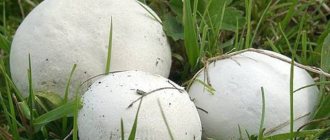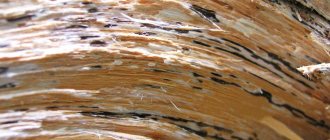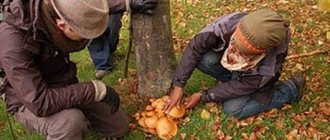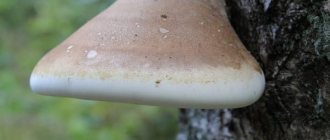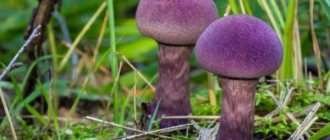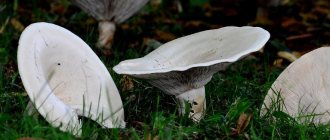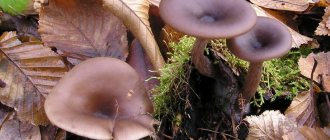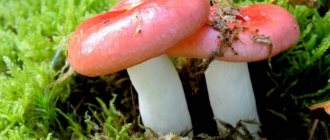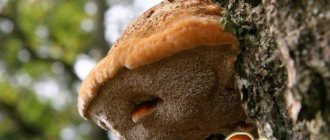Mushrooms
1
1624
Article rating
Kira Stoletova
Floaters (pusher mushrooms) are a species considered theoretically edible. It does not have high nutritional value and belongs to the Amanita genus. These are unattractive specimens both in appearance and taste.
Mushroom pushers
Brothers of the fly agaric
Pusher mushrooms - the tasty brothers of the fly agarics
Mushrooms, known as pushers or Floats, are a group of mushrooms from the fly agaric (Amanitaceae) family. There is considerable disagreement among mycologists regarding their classification - some consider them an independent genus, others a subgenus of the genus Amanita. For a simple Russian mushroom picker, however, the most important thing is that many types of Tolkachik are conditionally edible, and, with due care, are quite suitable for food.
Types of floats
Many pusher mushrooms, the photos and descriptions of which are very similar to each other, still belong to different species. The easiest way to distinguish them is by Volvo. In a gray float it is predominantly gray. The saffron, umber-yellow, large-volvo and yellow-brown mushrooms have red-brown spots on it.
The snow-white float differs from its relatives in its absolute whiteness. And only the center of its cap has a grayish or brown color.
The most famous and most collected among the representatives of its genus is the gray pusher.
General characteristics of the genus
Pusher mushrooms are tasty brothers of fly agaric mushrooms.
Compared to other fly agaric genera, pusher mushrooms have relatively small fruiting bodies.
Like all fly agarics, at the first stage of development, the fruiting body of the Floats looks like a small white egg, from which the cap-footed body of the mushroom then hatches.
Their cap There may be a tubercle on the cap, its surface is usually shiny and smooth or slightly slimy. Sometimes flakes from the original cover remain on the top of the cap, and it itself is extremely fragile, which makes transporting the collected mushrooms difficult.
The color of the cap varies, depending on the species, from whitish-gray to brownish-brown or reddish-orange.
The hymenophore is plate-type, the plates are frequent, widened in the center, freely placed, white or slightly grayish-pinkish in color. Spore powder is white.
The stalk is cylindrical, fragile, and often hollow with age. Depending on the type, it can be smooth, or have a scaly pattern, bare, or covered with a flake-like coating. The leg has a downward expansion, but without the swelling characteristic of other fly agarics. The color of the legs is usually grayish-white. There is no ring on the leg.
Like all fly agarics, the volva is preserved in the lower part - the remains of the original fruiting body - the eggs. It is deeply immersed in the soil, wide and leathery, loosely covering the stem. In old fruiting bodies, sometimes it completely disappears.
The pulp is brittle and thin, white in color, unchanged when cut, sometimes faintly colored near the edges of the cap.
Mushrooms Pushers - delicious brothers of fly agarics
grow on all continents except Antarctica, in forests of various types.
Application and beneficial properties
Pushers are conditionally edible mushrooms that require mandatory preliminary boiling before use.
The taste qualities of these mushrooms are usually not considered outstanding - their taste is defined as neutral, and the fragility of their fruiting bodies, which makes harvesting and cooking difficult, also does not add to their popularity. Before use, Tolkachiki must be properly cleaned, rinsed thoroughly with running water and boiled for an hour. After boiling, these mushrooms are suitable for various culinary purposes - they are used for appetizers, first and second courses, and can also be successfully dried and pickled.
Pusher meats are quite nutritious; they contain a lot of betaines, which have a positive effect on metabolic processes in the human body, and are also used in clinical medicine to combat diseases of the gallbladder, kidneys, liver, prostate adenoma, breast cancer and Alzheimer's disease.
Not for everyone
Pusher mushrooms - tasty brothers of fly agarics
Pusher mushrooms are a type of fly agaric, and they look very similar, so not every lover of quiet hunting will dare to put them in their basket, even knowing that they are edible. However, you can eat Tolkachiki, and they also have their admirers, who make up a certain category of mushroom pickers who are quite pleased with their culinary qualities. A lot about the taste of these mushrooms depends on the place where the fruiting bodies grow and the specific species, and, partly, on the cooking technology. Although officially these mushrooms are “so-so”, some types of Tolkachik are quite popular and are considered, among their connoisseurs, to be a very tasty and healthy treat.
Mushrooms Pushers - delicious brothers of fly agarics
Types of Pusher Mushrooms
Float Saffron Amanita Crocea
Mushrooms Pushers - delicious brothers of fly agarics
One of the most popular and delicious Pushers.
Appearance
The cap, up to 10 cm in diameter, is initially ovoid, becoming increasingly prostrate with age. Its surface is smooth, shiny in wet weather, with a characteristic ribbed edge. The color of the cap varies from saffron-yellow to yellow-orange, always darker in the center.
The hymenophore is lamellar, the plates are frequent and free, white in young fruiting bodies, creamy-yellowish in old ones. Spore powder is white.
The leg is up to 15 cm high and up to one and a half centimeters thick, yellowish-white in color, hollow, and thickened at the base. The leg is covered with small scaly belts and does not have a ring, but may have a slight bend in the middle. The volva, at the base of the stem, can often be completely buried in the ground.
The pulp is thin and brittle, without pronounced taste or smell, light or yellowish in color.
Where and when does it grow
Saffron float grows from the beginning of July to the end of September in mixed and deciduous forests, on the edges, woodlands and other bright places. Often found in swamps.
Culinary Use
Among lovers of this type of Tolkachik, there is disagreement about the need to boil it before eating. Some people simply pour boiling water over it before using it, while others immediately fry it raw. Many connoisseurs note its sweetish, corn-like taste, and claim that this mushroom is especially good when fried.
The question of the dangers of using Floats is also very controversial. There is evidence of serious poisoning by these mushrooms. On the other hand, the very high and well-known probability of confusing the Pusher with the Pale Toadstool raises doubts that the cause of those poisonings was the floats.
Float Gray Amanita Vaginata
Pusher mushrooms are the tasty brothers of the fly agarics.
A slightly less popular species among Pusher lovers, although the taste is not inferior to the Saffron Float.
Appearance
The cap is up to 12 cm in diameter, in youth it is round - bell-shaped or conical, then it becomes, at first, convex, then almost flat, with a tubercle in the middle. The cap is fleshy in the center, furrowed and thin at the edges, its skin is shiny and smooth, slimy in wet weather. The color of the cap is highly variable - from whitish-gray to yellow-brown shades. In young specimens, remnants of the original film are sometimes visible on it.
The hymenophore is lamellar, the plates are frequent and free, with a widening in the center, light in young specimens, and yellowish in mature specimens. Spore powder is white.
The leg is up to 18 cm high and up to 2 cm in diameter, slender and thin, with a smooth narrowing upward. The surface of the leg is longitudinally fibrous and smooth, can be covered with a flocculent coating, its color varies from whitish-gray to ocher and gray-brown. At the base, the stalk is surrounded by a wide and free volva, light at first, and turning brown with age. The leg ring is missing.
The pulp is soft, fragile and thin, light or slightly yellowish, without much odor, and with a sweetish taste.
Where and when does it grow
Gray float grows from May to November in light coniferous and deciduous forests, and is found in the steppe zone and in the mountains, especially in the company of mountain pine and green soul. Ubiquitous in Eurasia and North America, found in Australia and New Zealand, and certain areas of South America.
Culinary Use
It is believed that the mushroom can lead to intoxication if consumed without prior boiling, but the nature and degree of danger of the toxins it contains has not been determined. Its nutritional qualities are approximately similar to Saffron Float.
Float Yellow – Brown Amanita Fulva
Pusher mushrooms - tasty brothers of fly agaric mushrooms
Another fly agaric-like, but quite edible species. Also called Brown Float, Orange Fly Agaric and Yellow-Brown Fly Agaric.
Appearance
The cap is up to 8–10 cm in diameter, has a convex or bell-shaped shape in young specimens, and a pronounced flat shape, with a tubercle, in mature ones. The cap is slightly mucous, with a distinctly furrowed edge. As a rule, there are no remains of the bedspread on it.
The hymenophore is lamellar, the plates are free and frequent, white or cream in color. Spore powder is light.
The leg is up to 14 cm high and up to 1.2 cm in diameter, thickening downwards. Painted white-brown, smooth, sometimes covered with small felt scales. It becomes hollow with age. The volva at the base of the leg, free and sac-like, not attached to the leg, has a reduced brown tint. There is no ring on the leg.
The pulp is thin along the edges, fleshy in the center of the cap, watery and soft, of a light color. It tastes sweetish and has no distinct odor.
Where and when does it grow
This mushroom loves acidic soils and damp wetlands, grows in coniferous and mixed forests, and is also found in the steppe zone. Fruits in small groups or singly, from June to October, widespread in the temperate zone of Eurasia and North America, found in Japan, China and North Africa, Central Asia and Transcaucasia. In Russia, the Yellow-Brown Float is quite widespread in the central and southern regions.
Culinary use
The mushroom has a very good taste and is popular among connoisseurs. No toxins were found in this form, but it is still recommended to boil it for half an hour before use. Again, many experts recommend cooking these mushrooms for no more than 5 minutes to avoid loss of taste, and some fry them directly raw.
Snow-white floater (Amanita nivalis) what it looks like, where and how it grows, edible or not
Insert-tree-mushroom Synonyms Agaricus nivalis (Grev.) Loudon, 1829Agaricus vaginatus var. albidus Fr., 1838Amanita vaginata var. albida (Fr.) Gillet, 1878Amanita vaginata var. nivalis (Grev.) Guillaud et al., 1884 Amanitopsis nivalis (Grev.) Sacc., 1887 Pseudofarinaceus nivalis (Grev.) Kuntze, 1891 Amanitopsis vaginata var. nivalis (Grev.) Peck, 1894Vaginata nivalis (Grev.) Kuntze, 1898Amanitopsis albida (Fr.) S. Imai, 1933Amanita vaginata f. nivalis (Grev.) Veselý, 1933Amanitina nivalis (Grev.) E.-J. Gilbert, 1940Amanita vaginata f. oreina J. Favre, 1955
Etymolgy: Amanitopsis (Amanita + opsis - appearance, which means Amani-like.) nivalis (Latin nivalis - snowy).
The cap is 3.5-9.6 cm in diameter, at first bell-shaped, over time it becomes more or less prostrate, with a rounded tubercle protruding in the center, snow-white, light beige in the middle, with falling, white flaky remains from the general cover and with a radially striped ribbed edge, slightly mucous when young, then dry.
Laminae: free, white, widened towards the edges and narrowed at the stem.
The leg is 7.5-9 x 1 cm, cylindrical, swollen at the base and with a white sac-like vagina.
The pulp is white and thin. The taste and smell of the mushroom are pleasant.
Spores: 8.45-10.5 x 7.8-8.9 microns, ellipsoidal, smooth, colorless, with a drop of oil.
Spore powder: white.
Basidia: 30.9-37.8 x 8-9 µm.
Habitat: grows in forests and meadows.
Season: June-September.
Distribution in Kazakhstan: North Kazakhstan region, Akmola region, Pavlodar region, Almaty region.
Area: Russia, Lithuania, Latvia, Estonia, Germany, Czech Republic, Slovakia, France, North America.
Edibility: Edible, can be eaten fresh.
Similar species: very similar to the stinking fly agaric (Amanita virosa), which has not yet been recorded in Kazakhstan, but its presence cannot be ruled out. Therefore, it is better for inexperienced mushroom pickers to refrain from collecting this mushroom.
- DI. Samgina “Flora of spore plants of Kazakhstan. Volume XIII. 1. Agaricales”, “Science” Alma-Ata, 1981.
- S.P. Wasser “Flora of mushrooms of Ukraine. Basidiomycetes. Amanital mushrooms." Kyiv, “Naukova Dumka”, 1992.
- MycoBank.org
The most important
Pusher mushrooms are the tasty brothers of the fly agarics.
The most important thing to know when searching for and collecting Pusher mushrooms is that they are VERY similar to the Pale Toadstool. It is this fact that makes many mushroom pickers avoid these mushrooms - and perhaps this is the safest and most sensible strategy. Those who are not afraid to risk their health must remember the main signs that distinguish Pushers from their dangerous double:
- At the very beginning, the fruiting body of the toadstool resembles a white egg, from which the stem with the embryo of the cap then hatches. That is, exactly the same as with Tolkachikov. Conclusion, under no circumstances should you collect floats in the egg stage.
- The Pale Toadstool has the famous ring on its leg, which looks like a velvety skirt. Pushers don't have a ring. However, the ring of a toadstool can fall off over time, or due to accidental mechanical impact. In this form, it is easy to confuse the toadstool and floats. Therefore, when collecting Pusher, you need to very carefully check for the presence of a ring mark on the fruiting body.
- The cap of the Pale Toadstool is smooth, without any grooves, and all floats have the edges of the cap with a signature grooved pattern.
In a similar way, Pushers are distinguished from poisonous species of fly agarics, for example from the Bright Yellow Amanita Gemmata ,
Mushrooms Pushers - delicious brothers of fly agarics
but here you need to be even more careful - fly agarics also have grooves on their caps, which makes them very difficult to distinguish from floats.
Attention to all these signs can save the health and life of a collector who decides to feast on Pusher. According to experienced experts, distinguishing them from their poisonous counterparts is not at all difficult if you follow the rules and gain a little experience.
Mushrooms Floats or Pushers are an excellent example of not the most popular, but quite edible mushrooms that can bring considerable gastronomic pleasure to true connoisseurs of mushroom delicacies. Let their close relationship with poisonous species not frighten the attentive leader of a quiet hunt, forcing him only to be especially vigilant when searching for and collecting them.
Contraindications
This species does not pose a threat to human life and health. According to the description, it looks similar to a toadstool, so there is a high risk of confusing these mushrooms. In this case, intoxication of the body will occur. It is also possible to get poisoned from the float if it was collected near industrial areas or roads: it quickly absorbs toxic substances from the environment.
You should not eat mushrooms if you have a number of diseases:
- diabetes;
- poor kidney and liver function;
- hypertension.
The mushroom is excluded from the diet if there are allergic reactions to this particular species.
